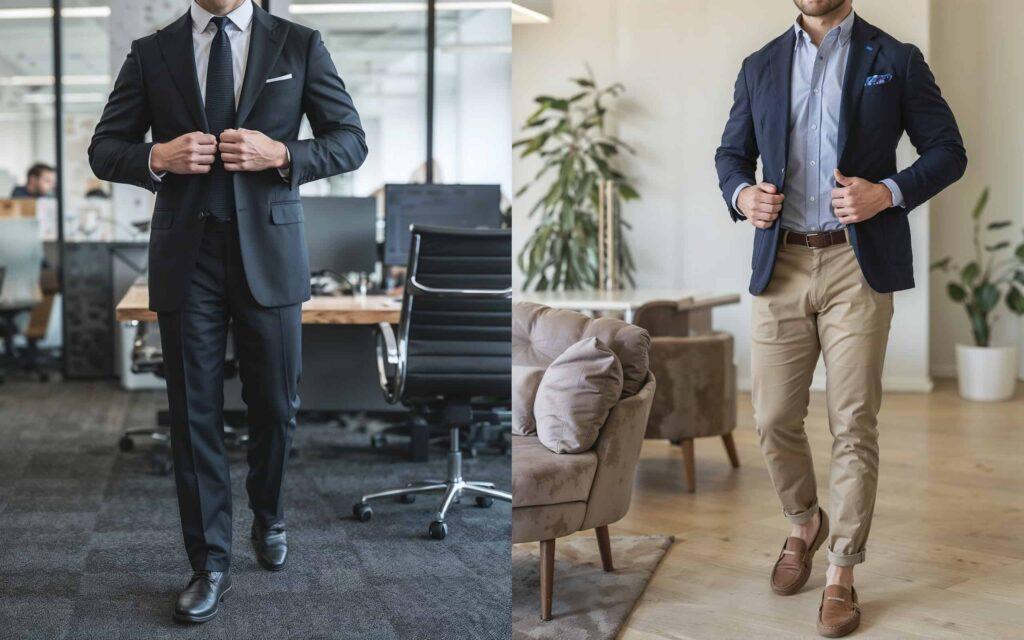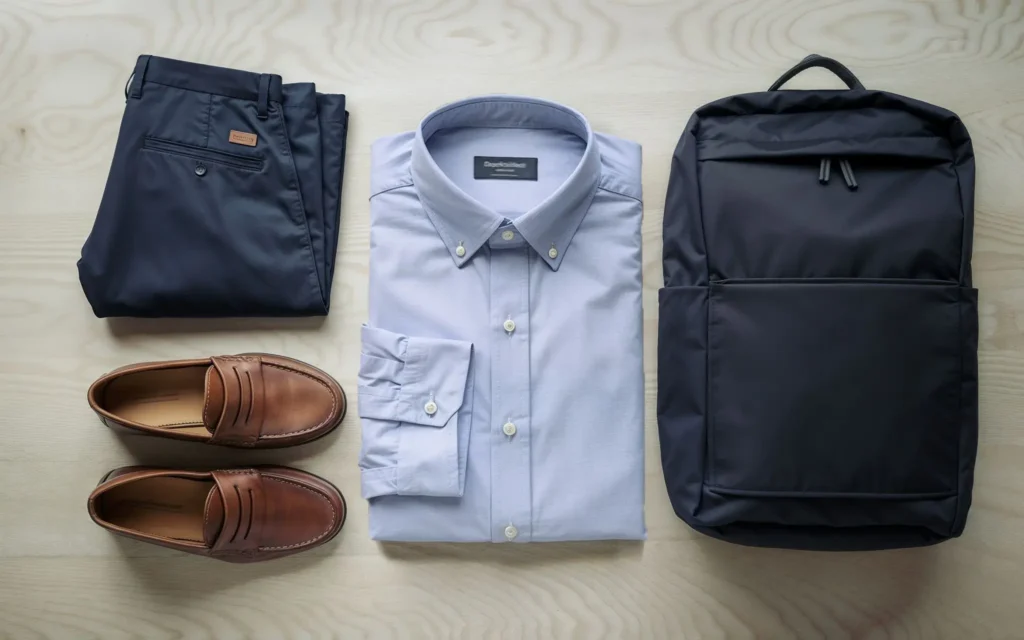Men’s Guide to Business Casual: Office-Ready Styles
Dressing for work today isn’t as straightforward as it used to be. The days of strict suits and ties are fading, and many offices now expect a more balanced look—professional yet comfortable. This is where “business casual” comes into play. But what exactly does business casual mean, and how can you get it right?
This guide will walk you through the essentials of office-ready business casual attire. From choosing the right shirt and pants to understanding what shoes fit the occasion, we’ll break down the key pieces that blend professionalism with comfort. Whether you’re starting a new job or updating your work wardrobe, learning how to dress in a way that fits both your office culture and your personal style is essential.
Let’s take a closer look at how to navigate the fine line between too casual and too formal, so you can dress with confidence and ease.
Contents
- What Even Is Business Casual, Anyway?
- The Building Blocks: Essential Business Casual Pieces
- Putting It All Together: Outfit Ideas That Work
- Seasonal Adjustments
- Color Coordination and Patterns: Adding Some Flair
- Tips for Colorblind Men
- Fit Is King: Getting the Right Size
- Business Casual Don’ts: Avoiding Common Pitfalls
- Adapting To Changing Workplace Trends
- Wrapping It Up
- FAQ
What Even Is Business Casual, Anyway?
Let’s start with the basics. Business casual is that middle ground between showing up in a full suit and tie and rolling into the office in your weekend jeans and tee. It’s professional but with the top button undone and the tie left at home.

The key word here is “business.” You’re still at work, so you want to look put-together and competent. But the “casual” part means you have room to inject some personality and comfort into your outfit.
Here’s a quick rundown:
- It’s more relaxed than traditional business wear
- But it’s not as laid-back as your off-duty clothes
- Think polished, but not overly formal
Now, here’s where it gets tricky. Business casual can mean different things depending on where you work, what industry you’re in, and even what part of the country (or world) you’re in. A tech startup in Silicon Valley might have a very different idea of business casual compared to a law firm in New York City.
What is the best way to figure out what flies in your office? Take cues from your colleagues, especially those in positions you aspire to. When in doubt, it’s better to err on the side of slightly more formal – you can always dress down later.
The Building Blocks: Essential Business Casual Pieces
Alright, let’s get into the meat of it. What exactly should you be wearing? Here’s a breakdown of the key pieces you need in your business casual wardrobe:

Shirts
- Button-downs: Your go-to. Opt for Oxford cloth or poplin in solid colors or subtle patterns.
- Polos: Great for warmer weather or more casual offices.
- Sweaters: Perfect for layering or on their own in cooler months.
Top pick: The Buttoned Down Men’s Classic Fit Supima Cotton Dress Shirt is a versatile staple that’ll serve you well. It’s crisp, comfortable, and comes in a range of colors.
Pants
- Chinos: The backbone of business casual. Get a few pairs in neutral colors.
- Dress pants: For when you need to step it up a notch.
- Khakis: A classic choice that works in most settings.
Recommended: Dockers Men’s Classic Fit Workday Khaki Pants are a solid choice. They’re durable, comfortable, and look sharp.
Shoes
- Loafers: Slip-on ease with a polished look.
- Oxfords: A bit more formal, great for dressier days.
- Brogues: Add some personality with these detailed dress shoes.
Our pick: The Clarks Men’s Tilden Cap Oxford Shoe is a comfortable, stylish option that works with various outfits.
Accessories
- Belts: Match your leather shoes for a cohesive look.
- Watches: A classic timepiece adds a touch of sophistication.
- Bags: A sleek messenger bag or briefcase completes your professional look.
Recommendation: A quality leather belt like the Dockers Men’s Casual Leather Belt can pull your whole outfit together.
Putting It All Together: Outfit Ideas That Work
Now that we’ve covered the basics, let’s talk about how to combine these pieces into killer outfits. The key is to mix and match while keeping things balanced.
Here are some foolproof combos:
1. The Classic Combo
- Light blue button-down shirt
- Navy chinos
- Brown leather loafers
- Brown leather belt
Why it works: It’s simple, clean, and professional. The blue and navy create a cohesive look, while the brown accessories add warmth.
2. The Layered Look
- White dress shirt
- Light gray V-neck sweater
- Charcoal dress pants
- Black oxford shoes
- Black belt
Why it works: Layering adds visual interest and keeps you prepared for temperature changes. The grayscale palette is sophisticated and easy to put together.
3. The Casual Friday Outfit
- Navy polo shirt
- Khaki chinos
- Brown brogues
- Matching brown belt
Why it works: It’s more relaxed but still put together. The polo keeps things casual, while the brogues add a touch of style.
Remember, these are just starting points. As you get more comfortable, start experimenting with different color combinations and patterns.
Seasonal Adjustments
- Summer: Opt for lighter fabrics like linen blends and cotton. Short-sleeve button-downs can work in more casual offices.
- Winter: Layer up with sweaters, cardigans, and blazers. Don’t forget a stylish overcoat for outdoor warmth.
Pro tip: Invest in a few quality, versatile pieces that you can mix and match. It’s better to have a smaller wardrobe of well-fitting, high-quality items than a closet full of so-so pieces.
Color Coordination and Patterns: Adding Some Flair
Now that you’ve got the basics down, let’s talk about adding some personality to your outfits. Color and pattern can take your business casual game from good to great, but it’s easy to overdo it. Here’s how to strike the right balance:
Safe Color Combinations
- Navy and white
- Gray and light blue
- Tan and burgundy
- Olive and white
These combos are classic for a reason – they look good on everyone and are hard to mess up.
Adding Patterns
Start small with patterns. A striped or gingham shirt under a solid sweater is a great way to dip your toe in. As you get more comfortable, you can try:
- Subtle plaids
- Microdot patterns
- Textured solids (like herringbone)
The key is to keep it balanced. If you’re wearing a patterned shirt, keep your pants and accessories solid. Vice versa if you’re rocking patterned pants.
Tips for Colorblind Men
- Stick to neutral colors like navy, gray, and tan
- Use apps like Color Blind Pal to help identify colors
- Ask for help from friends or family when building outfits
- Look for clothes with tags that clearly state the color
Remember, when in doubt, keep it simple. A well-fitting outfit in solid, complementary colors will always look sharp.
Fit Is King: Getting the Right Size
Here’s a secret: a $50 shirt that fits perfectly will look better than a $500 shirt that’s too big or small. Fit is the most crucial aspect of looking good in your clothes. Here’s a quick guide:
Shirts
- The shoulder seam should sit right at the edge of your shoulder
- You should be able to fit two fingers between your neck and the collar
- Cuffs should end at your wrist bone
Pants
- Should sit at your natural waist without needing a belt to stay up
- The hem should just touch the top of your shoes
- You should be able to pinch about 1-2 inches of fabric at the thigh
Jackets (if you wear them)
- The shoulder seam should align with your shoulder
- The sleeve should end at your wrist, showing about 1/4 inch of shirt cuff
- You should be able to easily button it without the fabric pulling
When To Visit a Tailor
If you find a piece you love but the fit is slightly off, don’t hesitate to get it tailored. Common alterations like hemming pants or taking in a shirt are usually inexpensive and can make a big difference in how you look.
Business Casual Don’ts: Avoiding Common Pitfalls
Even with the best intentions, it’s easy to slip up. Here are some common business casual mistakes to avoid:
- Wearing sneakers: Unless you work in a very casual tech startup, leave the athletic shoes at home.
- Overly wrinkled clothes: Invest in an iron or steamer. Looking rumpled is never professional.
- Flip-flops or sandals: Your toes should not be on display at the office.
- Shorts: Even in summer, stick to lightweight pants.
- Graphic tees: Save these for the weekend.
- Overly tight or baggy clothes: Neither extreme looks professional.
Remember, if you’re unsure whether something is appropriate, it’s probably best to err on the side of caution and choose something else.
Adapting To Changing Workplace Trends
The business world is always evolving, and so is business casual. Here are some current trends to be aware of:
Impact of Remote Work
- Video call-appropriate outfits (professional on top, comfortable on bottom)
- Increased acceptance of more casual styles as people return to the office
Emerging Styles
- “Smart casual” – a step down from business casual, but still office-appropriate
- Incorporation of athleisure elements in more casual offices
- Increased focus on sustainable and ethically-made clothing
To incorporate these trends:
- Stay observant of what others in your workplace are wearing
- Make gradual changes rather than overhauling your entire wardrobe at once
- Always prioritize looking professional and put-together over being trendy
Wrapping It Up
Alright, we’ve covered a lot of ground here. Let’s recap the key points:
- Business casual is about looking professional while being comfortable
- Fit is crucial – well-fitting basics beat ill-fitting expensive pieces any day
- Pay attention to your specific workplace culture
- Stay adaptable as workplace trends evolve
Remember, developing your business casual style is a journey. It’s okay to make mistakes – that’s how you learn what works for you. The goal is to feel confident and comfortable in what you’re wearing so you can focus on crushing it at work.
Don’t be afraid to experiment within the guidelines we’ve discussed. Your personal style is what will make you stand out (in a good way) while still looking appropriate for the office.
FAQ
Q: Can I wear jeans for business casual?
A: It depends on your workplace. In more relaxed offices, dark, well-fitted jeans without rips or distressing can work. When in doubt, opt for chinos instead.
Q: Are short-sleeve button-downs acceptable?
A: Generally, yes, especially in warmer climates or seasons. Just make sure they’re well-fitted and ironed.
Q: Do I always need to tuck in my shirt?
A: For button-downs, yes. Polo shirts can sometimes be left untucked if they’re designed for it (with a shorter, even hem).
Q: Can I wear a T-shirt under a blazer?
A: In very casual offices, a plain, high-quality T-shirt under a blazer can work. But it’s safer to stick with a collared shirt.
Q: Are boots okay for business casual?
A: Certain styles of boots, like Chelsea boots or dress boots, can work well in a business casual setting.